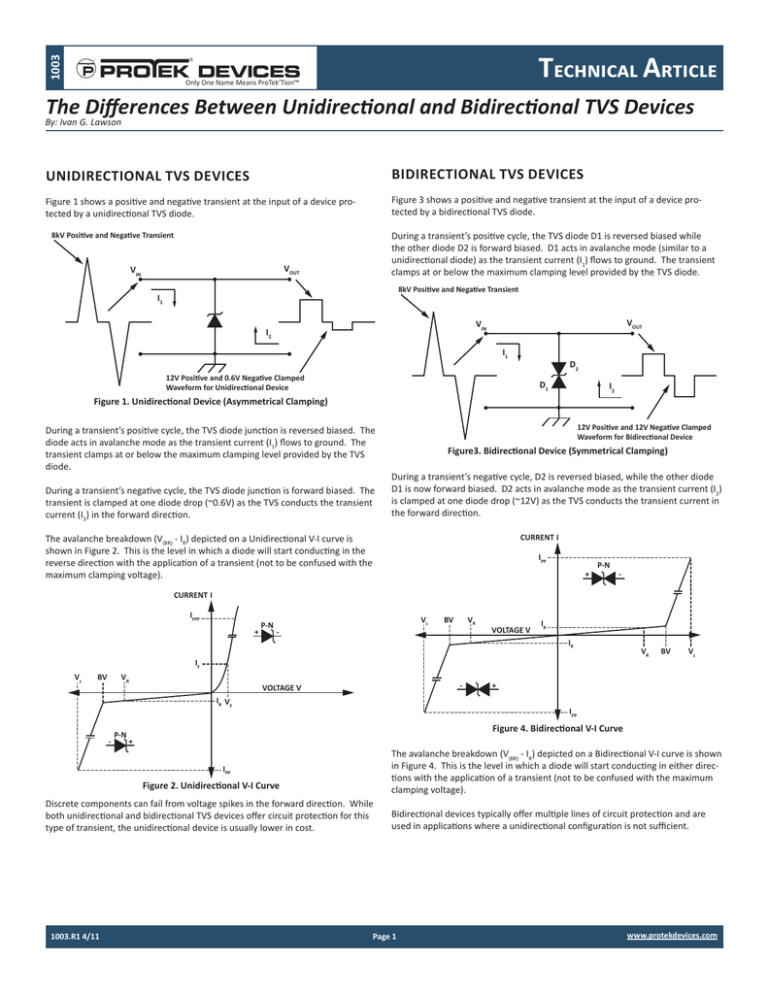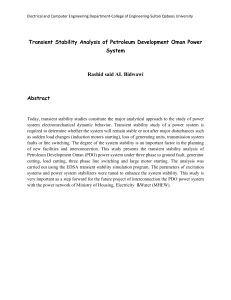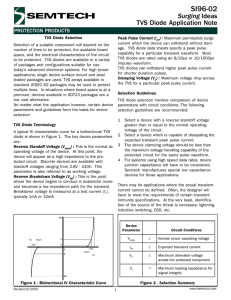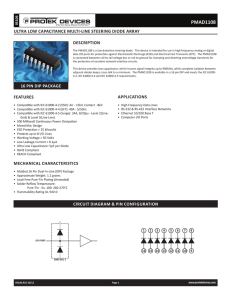The Differences Between Unidirectional and
advertisement

1003 Technical Article Only One Name Means ProTek’Tion™ The Differences Between Unidirectional and Bidirectional TVS Devices By: Ivan G. Lawson Unidirectional TVS Devices Bidirectional TVS Devices Figure 1 shows a positive and negative transient at the input of a device protected by a unidirectional TVS diode. Figure 3 shows a positive and negative transient at the input of a device protected by a bidirectional TVS diode. During a transient’s positive cycle, the TVS diode D1 is reversed biased while the other diode D2 is forward biased. D1 acts in avalanche mode (similar to a unidirectional diode) as the transient current (I1) flows to ground. The transient clamps at or below the maximum clamping level provided by the TVS diode. 8kV Positive and Negative Transient VOUT VIN 8kV Positive and Negative Transient I1 VOUT VIN I2 I1 D2 12V Positive and 0.6V Negative Clamped Waveform for Unidirectional Device D1 I2 Figure 1. Unidirectional Device (Asymmetrical Clamping) During a transient’s positive cycle, the TVS diode junction is reversed biased. The diode acts in avalanche mode as the transient current (I1) flows to ground. The transient clamps at or below the maximum clamping level provided by the TVS diode. During a transient’s negative cycle, the TVS diode junction is forward biased. The transient is clamped at one diode drop (~0.6V) as the TVS conducts the transient current (I2) in the forward direction. 12V Positive and 12V Negative Clamped Waveform for Bidirectional Device Figure3. Bidirectional Device (Symmetrical Clamping) During a transient’s negative cycle, D2 is reversed biased, while the other diode D1 is now forward biased. D2 acts in avalanche mode as the transient current (I2) is clamped at one diode drop (~12V) as the TVS conducts the transient current in the forward direction. CURRENT I The avalanche breakdown (V(BR) - IR) depicted on a Unidirectional V-I curve is shown in Figure 2. This is the level in which a diode will start conducting in the reverse direction with the application of a transient (not to be confused with the maximum clamping voltage). IPP + P-N - CURRENT I IFPP + P-N Vc BV VR - VOLTAGE V IR IR IF Vc BV VR - VOLTAGE V IR VF - P-N BV Vc + IPP Figure 4. Bidirectional V-I Curve + The avalanche breakdown (V(BR) - IR) depicted on a Bidirectional V-I curve is shown in Figure 4. This is the level in which a diode will start conducting in either directions with the application of a transient (not to be confused with the maximum clamping voltage). IPP Figure 2. Unidirectional V-I Curve Discrete components can fail from voltage spikes in the forward direction. While both unidirectional and bidirectional TVS devices offer circuit protection for this type of transient, the unidirectional device is usually lower in cost. 1003.R1 4/11 VR Bidirectional devices typically offer multiple lines of circuit protection and are used in applications where a unidirectional configuration is not sufficient. Page 1 www.protekdevices.com 1003 Technical Article Only One Name Means ProTek’Tion™ company information COMPANY PROFILE ProTek Devices, based in Tempe, Arizona USA, is a manufacturer of Transient Voltage Suppression (TVS) products designed specifically for the protection of electronic systems from the effects of lightning, Electrostatic Discharge (ESD), Nuclear Electromagnetic Pulse (NEMP), inductive switching and EMI/RFI. With over 25 years of engineering and manufacturing experience, ProTek designs TVS devices that provide application specific protection solutions for all electronic equipment/systems. ProTek Devices Analog Products Division, also manufactures analog interface, control, RF and power management products. CONTACT US Corporate Headquarters 2929 South Fair Lane Tempe, Arizona 85282 USA By Telephone General: 602-431-8101 Sales: 602-414-5109 Customer Service: 602-414-5114 By Fax General: 602-431-2288 By E-mail: Sales: sales@protekdevices.com Customer Service: service@protekdevices.com Technical Support: support@protekdevices.com Web www.protekdevices.com www.protekanalog.com COPYRIGHT © ProTek Devices 2011 - This literature is subject to all applicable copyright laws and is not for resale in any manner. SPECIFICATIONS: ProTek reserves the right to change the electrical and or mechanical characteristics described herein without notice. DESIGN CHANGES: ProTek reserves the right to discontinue product lines without notice and that the final judgement concerning selection and specifications is the buyer’s and that in furnishing engineering and technical assistance. ProTek assumes no responsibility with respect to the selection or specifications of such products. ProTek makes no warranty, representation or guarantee regarding the suitability of its products for any particular purpose, nor does ProTek assume any liability arising out of the application or use of any product or circuit and specifically disclaims any and all liability without limitation special, consequential or incidental damages. LIFE SUPPORT POLICY: ProTek Devices products are not authorized for use in life support systems without written consent from the factory. 1003.R1 4/11 Page 2 www.protekdevices.com




